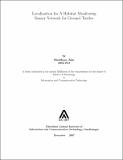| dc.contributor.advisor | Ranjan, Prabhat | |
| dc.contributor.author | Jain, Shubham | |
| dc.date.accessioned | 2017-06-10T14:37:19Z | |
| dc.date.available | 2017-06-10T14:37:19Z | |
| dc.date.issued | 2007 | |
| dc.identifier.citation | Jain, Shubham (2007). Localization for a habitat monitoring sensor network for ground turtles. Dhirubhai Ambani Institute of Information and Communication Technology, viii, 109 p. (Acc.No: T00143) | |
| dc.identifier.uri | http://drsr.daiict.ac.in/handle/123456789/180 | |
| dc.description.abstract | This thesis work deals with the localization problem (i.e. finding the location of the sensor nodes) in sensor networks. This work is specifically concerned with the localization of the sensor nodes on small ground turtles in the campus of Wildlife Institute of India (WII), Dehradun, India. The location information about the turtle node will be helpful to the scientists at WII to conserve the turtles. The wildlife scientists are interested in knowing the places where turtles go, what food they eat and the temperature and humidity of the place where they hibernate. The primary purpose of the sensor network deployment is habitat monitoring and not location determination. The energy constraint which sensor networks usually have is partly removed by deploying a grid of fixed nodes which have electric supply. But the nodes on turtles have this constraint and the lifetime of the nodes on turtles can be roughly one year. There is a weight constraint. The weight of the node on turtles cannot be more than 25 gms. This constraint restricts the measurement technique that can be used for the localization. So Received Signal Strength or range-free localization will be used. The location information cannot be just 2D as the terrain in the WII campus is not flat surface but has highs and lows. So 3D location information will be available through the algorithm. Also, the network is not static as the turtles move although with a slow speed of about 10 cm/s. The accuracy of the location can be 10 m as the primary motive of this application is to find where the turtles go for eating food. This thesis report does not contain implementation details about the project although some details about the prototype network to be deployed are given. Also, there is a comparison of two localization algorithms that can be used for the implementation. | |
| dc.publisher | Dhirubhai Ambani Institute of Information and Communication Technology | |
| dc.subject | Sensor networks | |
| dc.subject | Algorithms | |
| dc.subject | Coding theory | |
| dc.subject | Computer network protocols | |
| dc.subject | Databases and data processing | |
| dc.subject | Localization | |
| dc.subject | Ground turtles | |
| dc.classification.ddc | 681.2 JAI | |
| dc.title | Localization for a habitat monitoring sensor network for ground turtles | |
| dc.type | Dissertation | |
| dc.degree | M. Tech | |
| dc.student.id | 200511018 | |
| dc.accession.number | T00143 | |

